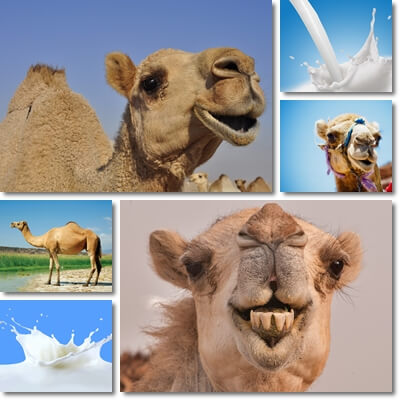Pre-modern desert peoples relied heavily on camel milk for both its nutritional benefits and healing properties. Its consumption was and is still believed to promote a return to good health and strengthen the body. Traditional uses for this special milk included matters of the digestive system, primarily diarrheal diseases, but also conditions that affected the heart and cardiovascular system. The therapeutic potential of dromedary milk further included benefits for the liver and lungs and anti-diabetic properties.
Complementary and alternative medicines recommended the milk for an array of infectious conditions due to its now scientifically proven antimicrobial activity as well as as for constipation, anemia, arthritis, lactose intolerance and as a solution to milk allergies. Many other traditional uses are mentioned in scientific literature and camel milk does indeed hold some degree of curative effects of various proportions for an array of health conditions. Here are 15 traditional uses of camel milk and their effectiveness ranked according to scientific research:

1) Treatment for diarrhea
Camel milk is not a treatment for diarrhea per se, but does hold benefits, both for bacterial and viral diarrheal diseases (essentially gastroenteritis). The raw milk (fresh and fermented, but not boiled), helps build a healthy gut flora ecosystem – or the microorganisms living peacefully and productively in the human gastrointestinal system. A healthy gut flora hinders and ultimately suppresses the growth and multiplication of microorganisms that cause disease such as bacteria or viruses that cause diarrheal diseases. This helps shorten infection time, speed recovery and sometimes even prevent diarrheal diseases altogether.
2) Good for the common cold and flu
While the milk does not actually prevent you from getting a cold or the flu, it can speed recovery and help ease some of the symptoms. On the one hand, the milk stands out as a source of good nutrition, with 3.2-3.4 g of fat, 2.9-3.2 g of protein, good amounts of vitamins A, C, D, E, B2, B12, calcium, copper, iron, magnesium, potassium, phosphorus, sodium, zinc. It’s actually regarded as more nutritious than cow’s milk, having more vitamin C, vitamin B12, iron and potassium. Regular consumption strengthens the body and supports the immune function, promoting quick recovery and a return to good health.
On the other hand, camel’s milk is full of antimicrobial agents such as immunoglobulins and lactoferrin (proteins) and lysozyme and lactoperoxidase (enzymes). Studies show they actively contribute to the immune system response via their antibacterial, antiviral, antifungal and anti-inflammatory activities. It even contains a protein that can recognize peptidoglycan, a cell wall in bacteria, as well as aromatic oils from medicinal herbs the animal may feed on – which hold antibacterial properties. Its composition explains its use as a traditional remedy for respiratory infections.

3) Effective against intestinal parasites
Now this is considered a stretch considering the bewildering variety of intestinal parasites and the fact they don’t all respond to the same treatment. However, the claim holds some truth to it. Originally, camel milk would be consumed raw, either fresh or fermented. Both forms of the milk contributed to intestinal flora with live beneficial bacteria. This helped strengthen and enrich existing gut flora populations. And thriving gut flora populations have been scientifically proven to inhibit the growth of pathogenic microorganisms, whether bacteria, viruses, fungi or parasites and, often times, destroy them. Find out more about Worms and Intestinal Parasites and how to treat them.
4) Soothes stomach pain and stomach upset
Camel’s milk was traditionally used as a natural remedy for digestive upset and stomachaches, colic, cramps etc. One reason for its effectiveness in calming digestive upset was the fact that it contained aromatic oils with various therapeutic properties. The presence of aromatic oils in the milk was the result of camels feeding on various aromatic plants (domesticated or undomesticated).
Scientific literature mentions camels would eat rosemary which contains aromatic oils with anti-inflammatory and mild analgesic properties (as well as expectorant and decongestant effects). Hyssop was also part of the animal’s diet and it too contains aromatic compounds with soothing properties. Depending on the region where the animal was from and the time of year, they would have access to various aromatic herbs with medicinal properties.
5) Counteracts acid reflux, soothes heartburn
Camel and other types of milk have been used for acid reflux and heartburn treatment since pre-modern times. But camel might have been preferred to other types because of its typically lower fat content (although there may be significant regional variations in fat content and camel’s milk may range from 1.8% to 5% fat or more). The milk was helpful as a short term solution because it formed a protective film over mucous membranes irritated by gastric juices and allowed for temporary relief. If chilled, the effects are more pregnant. Nonetheless, this is a short-term solution with short-term results. Moreover, if used excessively, it can cause acid reflux and subsequent heartburn. Also see Foods to Eat and to Avoid for Acid Reflux.
6) As good as mother’s milk
Camel’s milk was used in the past to supplement newborns’ diets when the mother did not produce enough milk and sometimes even completely replaced it. It was also used as a substitute for cow, goat and sheep milk as it seemed to not elicit side effects such as intolerance or acid reflux in babies and small children. Scientific research appears to confirm this practice and supports the idea that camel’s milk is almost as good as mother’s milk. In addition to its good nutritional value, in certain respects superior to other types of animal milk, it provides antimicrobial agents that further benefit the child’s development as well as does not contain proteins that normally cause milk allergy. Currently, there appears to be a return to camel’s milk for the complementary nutrition of babies and young children, especially those with acid reflux and other adverse reactions to other types of milk.
7) Builds strong bones and teeth
Drinking camel’s milk was though to help build strong bones and teeth. In children, it was used to help prevent rickets, while in adults it was consumed for the purpose of preventing frail bones and osteoporosis. And its benefits for bones stand true as the milk is a source of calcium, magnesium and phosphorus, three minerals that help make up bones. A good intake and a good balance of the three minerals, complemented by adequate intake of vitamin D, contributes to a healthy bone density and essentially strong bones and teeth.
8) Good for brain development; also nourishes the brain
You can say camel milk is a brain food: it has fat, including good amounts of healthy unsaturated fatty acids such as alpha-linoleic acid (Omega-6), but also some cholesterol, protein which is made of amino acids, B vitamins, especially vitamin B12. The brain is made up of fat and eating fats helps keep it nourished and working optimally as well as prevent brain fog. Cholesterol and vitamin B12 protect the coating surrounding the tail of nerve cells (the myelin sheath) which provides insulation and effective brain-body communication. The amino acids that make up protein help synthesize neurotransmitters that regulate mood, appetite, sleep and other functions. Children would be given camel’s milk for good mental development.
9) Remedy for high blood pressure
Multiple sources claim camel’s milk is richer in potassium than cow’s (although they do not specify the exact content of the mineral) and has modest amounts of magnesium. The two electrolytes regulate electrical impulses that get sent by the brain to every muscle in the body, including the heart. This helps maintain normal heart rhythm and healthy blood pressure numbers. Moreover, potassium relieves pressure in blood vessels, further contributing to healthy blood pressure values. However, if camels would feed on salty vegetation, their milk would also contain higher sodium amounts (excess sodium causes hypertension). Also see what other Foods to Eat for Hypertension.
10) Used as diabetes remedy
There are several explanations to why the milk is used traditionally for diabetes management. First of all, research shows camel’s milk contains significant amounts of the hormone insulin as well as proteins with insulin-like activity. Moreover, studies show the insulin in the milk evades digestion by gastric juices and reaches the intestinal system where it’s absorbed and can produce its blood-sugar lowering effects (test subject given camel milk experienced drops in blood sugar levels). Secondly, the milk is a low-glycemic food which means consumption does not cause important fluctuations in blood sugar levels.
11) Constipation relief
The fact that it is up to 88-90% water and contains fat to help ease the passing of bowel movements through the intestinal tract explains why camel’s milk has been traditionally used to treat constipation. The good amounts of potassium and magnesium which reset electrolyte balance and fluid balance in the body further contribute to constipation relief. The naturally fermented milk has laxative effects. Find out my 7 Easy Tricks to Treat Constipation.
12) Better for lactose intolerance
Although there may be significant variation in the nutritional profile of camels milk from different geographical regions, on average, it is lower in lactose than cow, goat and sheep milk. This would mean that it is less likely to trigger symptoms of intolerance and may represent a better option for those with milder forms of lactose intolerance (who experience milder symptoms, but can nonetheless have whole milk in moderation).
13) Used for milk allergy
Camel’s milk has long been given to children who experienced adverse reactions to other types of milk. This was before it was known that it did not contain beta-lactoglobulin and beta-cassein, two proteins now proven to cause milk allergy. Studies show it’s better tolerated than cow and goat milk even by children with allergy to them (although not by all).
14) Tuberculosis and hepatitis treatment
Sources report camel’s milk was used in the past as a treatment for tuberculosis and hepatitis, two highly infectious diseases. The likely explanation for its use for the conditions is its now proven antimicrobial value (immunoglobulins and lactoferrin, lysozyme and lactoperoxidase enzymes) which may have contributed to a limited improvement of the conditions or their symptoms. Its good nutrition would have exerted a strengthening effect on the body.
15) Treatment of anemia
Camel’s milk is a source of vitamin B12 and iron, two essential nutrients that help in the production of red blood cells and transport of oxygen to tissues. A deficiency of either of the two results in palor, tiredness, muscle weakness and an entire range of symptoms of anemia. The milk being a source of both, it was traditionally used to treat anemia. Its therapeutic potential meant it had a revitalizing, energizing effect.
